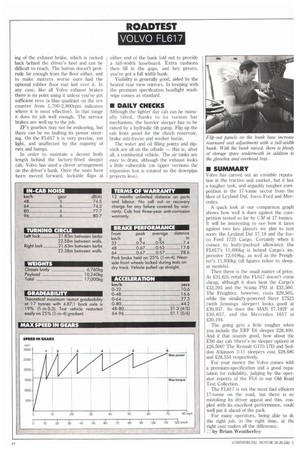ROADTEST VOLVO FL617
Page 44

If you've noticed an error in this article please click here to report it so we can fix it.
Mg of the exhaust brake, which is tucked back behind the driver's heel and can be difficult to reach. The button doesn't protrude far enough from the floor either, and to make matters worse ours had the optional rubber floor mat laid over it. In any case, like all Volvo exhaust brakes there is no point using it unless you've got sufficient revs (a blue quadrant on the rev counter from 1,700-2,800rpm indicates where it is most effective). In that range it does its job well enough. The service brakes are well up to the job.
ZF's gearbox may not be endearing, but there can be no faulting its power steering. On the FL617 it is very precise, yet light, and unaffected by the majority of ruts and bumps.
In order to maintain a decent body length behind the factory-fitted sleeper cab, Volvo has used a clever arrangement on the driver's bunk. Once the seats have been moved forward, lockable flaps at either end of the bunk fold out to provide a full-width baseboard. Extra cushions then fill in the gaps, and hey presto, you've got a full width bunk.
Visibility is generally good, aided by the heated rear view mirrors. In keeping with the premium specification headlight washwipe comes as standard.
• DAILY CHECKS
Although the lighter day cab can be manually tilted, thanks to its torsion bar mechanism, the heavier sleeper has to be raised by a hydraulic tilt pump. Flip up the cab front panel for the clutch reservoir, brake anti-freeze and washer bottle.
The water and oil filling points and dipstick are all on the offside — this is, after all, a continental vehicle. The air tanks are easy to drain, although the exhaust looks a little vulnerable (on tipper versions the expansion box is rotated so the downpipe projects less).
• SUMMARY
Volvo has carved out an enviable reputation in the tractive unit market, but it has a tougher task, and arguably tougher competition in the 17-tonne sector from the likes of Leyland Daf, lveco Ford and Mercedes.
A quick look at our comparison graph shows how well it does against the competition tested so far by CM at 17 tonnes. It will be interesting to see how it fares against two key players we plan to test soon: the Leyland Daf 17.18 and the lyeco Ford 1721 Cargo. Certainly when it comes to body/payload allowance the FL617's 11,690kg is behind Cargo's impressive 12,019kg, as well as the Freighter's 11,930kg (all figures relate to sleeper models).
Then there is the small matter of price. At 231,625 retail the FL617 doesn't come cheap, although it does beat the Cargo's 232,205 and the Scania P93 at 232,560. The Freighter, however, costs 229,505, while the similarly-powered Steyr 17S21 (with Jennings sleeper) looks good at 230,937. So does the MAN 17.192F at 230,657, and the Mercedes 1617 at 230,194.
The going gets a little tougher when you include the ERF E6 sleeper 228,400. And if that sounds good, how about the ES6 day cab (there's no sleeper option) at 226,500? The Renault G170.17D and Seddon Atkinson 2-11 sleepers cost £28,680 and 228,554 respectively.
For your money the Volvo comes with a premium-specification and a good reputation for reliability, judging by the operator reports of the FL6 in our Old Road Test Collection.
The FL617 is not the most fuel efficient 17-tonne on the road, but there is no mistaking its driver appeal and this, coupled with its excellent performance, could well put it ahead of the pack.
For many operators, being able to dc the right job, in the right time, at the right cost makes all the difference.
Z. by Brian Weatherley








































































































































